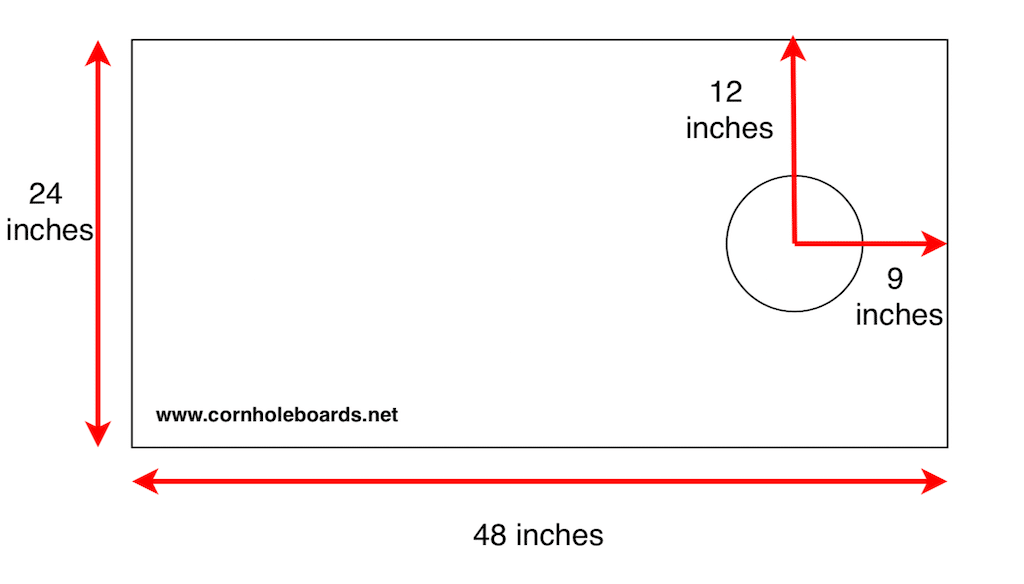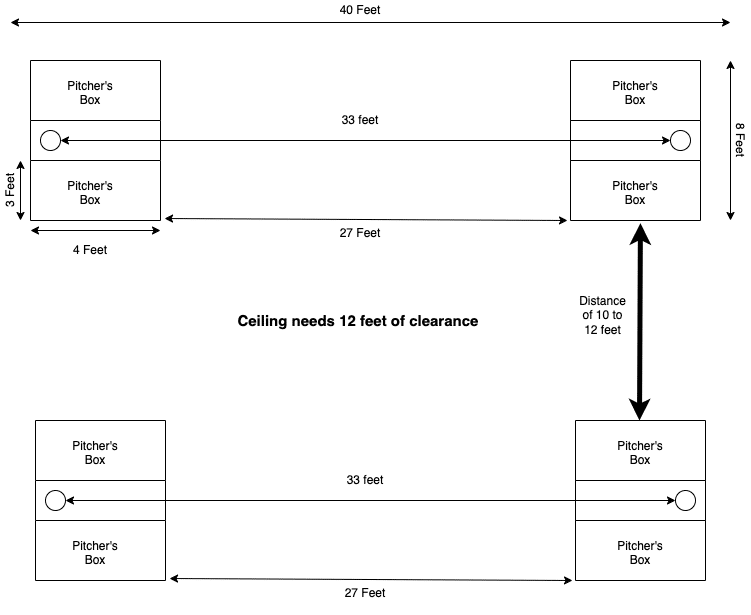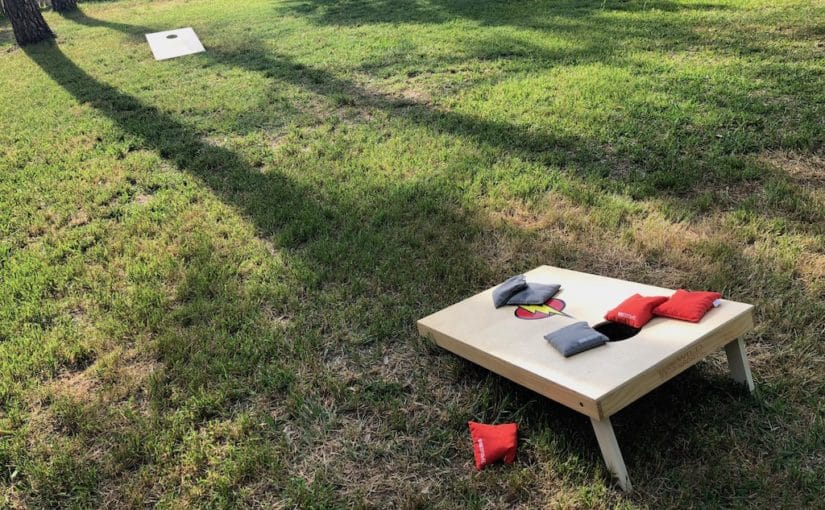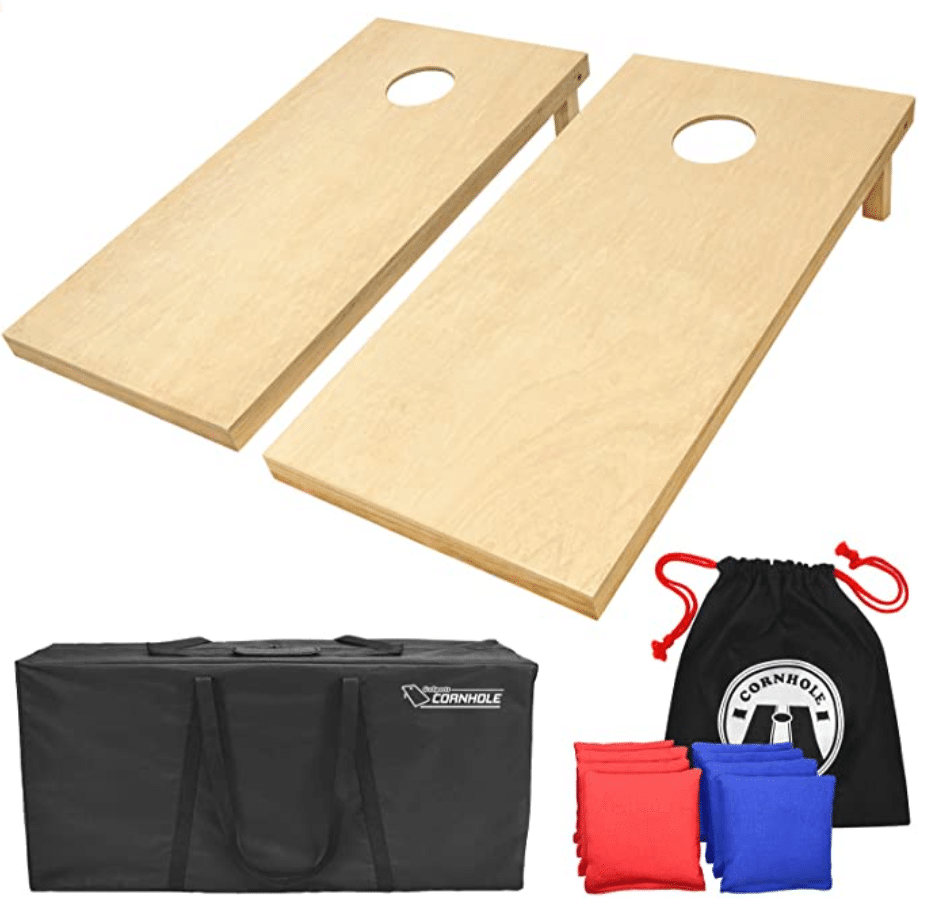When you’re trying to buy a cornhole board you want to make sure that you get a board that fits your needs. Many people don’t realize it, but cornhole boards can come in a number of different sizes.
In this article I’ll show you which size cornhole board you should get based on a few factors.
If you’re brand new to cornhole and trying to get a grasp on the game, check out my quick guide on how to play cornhole here.
You’ll be up to speed in no time!
Get a quality cornhole board set right now!
Check out my #1 recommendation for a quality cornhole board set that is perfect for beginners.
Do you want a regulation-sized board?
An ACO certified (American Cornhole Organization) regulation-sized cornhole board is 4 feet by 2 feet and should weight at least 25 pounds although some weigh much more. (You can read more about cornhole board dimensions here.)
A full-sized cornhole board is pretty large.
4 feet by 2 feet doesn’t sound like much but if you have a small vehicle or a small yard, these cornhole boards can be very bulky and take up more room than expected.
Think of it this way, two cornhole boards will take up eight feet from the board alone. So unless you have 35 feet to play with, you don’t have enough room for a full sized cornhole court (more on that below).
But if you have the room and like to keep your games official and as competitive as possible, then you probably should just go with a regulation-sized cornhole board.
While cornhole is all about having fun, there’s just something that feels good about playin on regulation-sized boards much like in other sports like pool. Plus, it give you more space to land bags on the board (these are called “woodies” and are worth one point).
It’s also nice to have so that when you have people over, they can play on a real cornhole board instead of a miniaturized version of one.

How heavy of a board do you want?
Another thing you definitely want to consider is how the cornhole board is constructed.
Cornhole boards usually are built with a frame made with 2 by 4s and a top playing surface made of plywood, usually 1/2″ thick or 3/4″ thick. (There are several different types of wood suitable for a cornhole board but many go with birch plywood.)
The thickness of the plywood can make a big difference in weight, especially when you factor in that you’ll be carrying around two of these boards.
I’d recommend going with a 1/2″ thick plywood to reduce the weight of the board.
Some cornhole boards also have a cross-beam for support in order to reduce bouncing. If you want to reduce the weight of your cornhole set then avoid adding a cross-beam to a board with 3/4″ thick plywood. That set-up could get heavy real quick.
If you’re not going to be carrying around your cornhole boards a lot then weight isn’t a huge issue. But don’t forget that you’ll still need to put up and store your boards somewhere so that they don’t get ruined by weather.
If your boards are very heavy then moving those things around all the time can get very annoying.
Do you want a tailgate-sized board?
If you’re wanting something a bit more compact and lightweight then you might want to go with a tailgate-sized board.
These are usually 3 feet by 2 feet, so they are one foot shorter than a regulation-sized board. Some tailgate boards are collapsable and even folder over, allowing them to be very compact.
That might not sound like a lot but having two boards that are one foot shorter can make lugging them around substantially easier.
Also, if your space is limited, as it often can be at special events or parties, then having smaller boards can make your life much easier to put together a cornhole court.
An official cornhole court will have the boards 27 feet apart but many people play 24 feet apart. If you’re using smaller tailgate-sized boards then it can really make sense to play 24 feet apart since you’re dealing with a smaller target (at least when you’re talking about the actual board.
Another plus about tailgate-sized board is that they are usually cheaper. So if you’re not 100% committed to the sport of cornhole and you want to save a few bucks, a tailgate-sized board might be just right for you.

Do you want to play indoors?
If you like to play cornhole year-round then you might want to play indoors.
Playing indoors has its advantages since your pitches aren’t as affected by cross winds and other weather elements. But this big challenge when playing indoors is usually that there’s just not a lot of space.
For this reason, you may want to go with a tailgate-sized board if you’re planning on playing indoors.
Or if you want to go with something a bit smaller, you can look into a junior-size board which I talk about below.
You can read more about playing cornhole indoors here.
Are there boards for kids?
Junior-sized cornhole boards come in a few different sizes but I would probably go with a board that is at least 2 feet by 1 foot.
Anything smaller than that and the cornhole board becomes almost too small.
Remember that kids are allowed to throw from 21 feet away from the cornhole board. So many times they don’t need a special cornhole board and can do just fine by being placed closer to the cornhole board.
What kinds of bags do you want?
Standard sized cornhole bags are 6 inches by 6 inches and should weight 15 to 16 ounces. If you’re trying to keep things official then I recommend that you go with bags that size.
But if you’re playing on a small board like a junior-sized board, it might be necessary to go with smaller bags.
Another thing you want to consider is if you want bags filled with corn feed or plastic resin.
Corn feed is the traditional route to go with and those bags usually produce a fine dust which helps the bags to slide better on the cornhole board. But they come with the risk of degrading and being subject to critters and mold, and even attracting unwanted hungry animals.
Plastic resin pellets won’t give you that dust but they are usually weatherproof and will last much longer. You also don’t have to worry about critters getting into them.
You can read more about the plastic resin pellets versus corn-filled bags debate here.
Final word
If you consider all of these factors before making your cornhole board purchase, you’ll be able to pick out the cornhole board that is just right for you and your crew.


